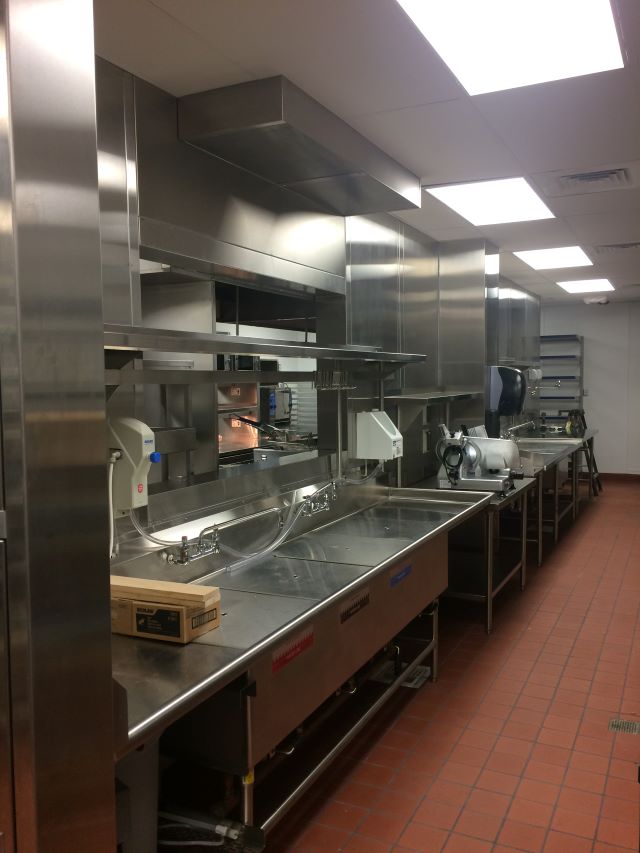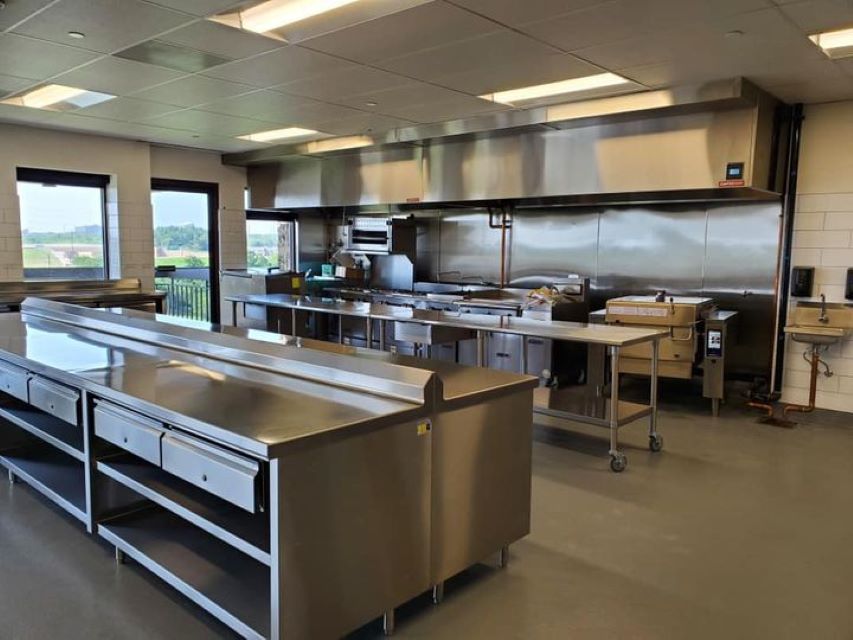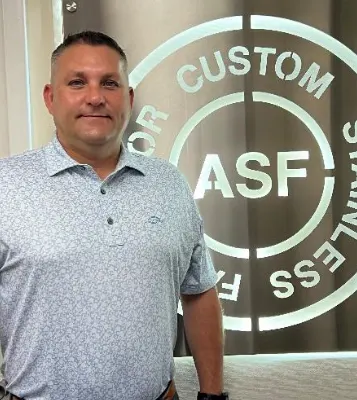Are your stainless steel exhaust hoods in excellent condition, or are they silently crying out for attention? You might be surprised how often these vital kitchen components are neglected. You must maintain a safe and efficient workspace as a commercial kitchen operator. A comprehensive maintenance checklist for your stainless steel hood isn’t just a good idea—it’s necessary for compliance, safety, and prime performance. By following a structured routine, you’ll extend the lifespan of your equipment and avoid costly breakdowns. But where should you start, and what are the core areas you can’t afford to overlook?
Regular Cleaning Schedule

Establish a rigorous cleaning schedule for your stainless steel exhaust hoods, ensuring you tackle grease buildup and potential fire hazards at least weekly.
Begin by removing and cleaning the grease filters. Soak them in a mixture of hot water and degreaser for 30 minutes, then scrub with a non-abrasive brush. Rinse thoroughly and allow to dry completely before reinstalling.
Next, wipe down the hood’s interior surfaces with a clean cloth soaked in a commercial degreaser. Pay special attention to corners and crevices where grease tends to accumulate. Use a plastic scraper for stubborn buildup, and be careful not to scratch the stainless steel surface.
Don’t forget to clean the fan blades and housing. Use a degreaser and cloth to remove any grease or debris. Inspect the blades for any signs of damage or imbalance.
Use a stainless steel cleaner and microfiber cloth to maintain the exterior’s shine and prevent corrosion. Always wipe in the direction of the grain to avoid scratches.
Document each cleaning session in a logbook, noting any issues or areas requiring extra attention. This record will help you identify patterns and adjust your cleaning routine.
Filter Inspection and Replacement
While regular cleaning is indispensable, you should also focus on the condition of your stainless steel exhaust hoods’ filters through routine inspection and timely replacement.
Examine your filters weekly for common problems such as signs of wear, damage, and excessive grease buildup. Also, check for holes, warping, or loose components that could compromise filtration effectiveness.
When inspecting, remove the filters and hold them to a light source. If you can’t see the light passing through, it’s time for a thorough cleaning or replacement. Pay attention to the filter’s edges and seals, guaranteeing they’re intact to prevent grease bypass. For baffle filters, verify that the baffles move freely and aren’t clogged with debris.
Replace filters that show signs of corrosion, have damaged frames, or can’t be adequately cleaned. Depending on usage, most commercial kitchen filters should be replaced every 3-6 months. Keep spare filters on hand to minimize downtime during replacements.
When installing new filters, ensure they fit snugly and are oriented correctly for optimal airflow and grease capture. Document all inspections and replacements in your maintenance log to track filter performance and lifespan, helping you anticipate future replacement needs.
Fan Blade Maintenance
Regularly inspect and clean your stainless steel exhaust hoods’ fan blades to guarantee satisfactory performance and prevent imbalance. To ensure safety, start by turning off the energy supply.
Remove the fan housing and carefully examine each blade for signs of damage, such as cracks, dents, or warping. If you spot any issues, replace the affected blades immediately to maintain proper airflow and prevent further damage.
Clean the blades thoroughly using a degreasing solution and a soft cloth. For stubborn grease buildup, use a plastic scraper, being careful not to scratch the surface. Pay close attention to the blade edges and corners, where debris often accumulates. After cleaning, dry the blades completely to prevent rust formation.
Check the fan’s balance by spinning it manually. If you notice any wobbling or unusual noises, it may indicate an imbalance. In this case, you’ll need to rebalance the fan or replace it entirely. Lubricate the fan bearings using food-grade lubricant, typically every six months, according to the manufacturer’s recommendations.
Electrical Component Check
After addressing fan blade maintenance, you must conduct a thorough electrical component check to guarantee your stainless steel exhaust hoods’ safe and efficient operation. Start by disconnecting the energy supply to ensure your safety.
Inspect all wiring for signs of fraying, loose connections, or heat damage. Pay close attention to the motor’s electrical connections and any control panels associated with the hood system.
Use a multimeter to test the continuity of switches, relays, and other electrical components. Verify that all ground connections are secure and free from corrosion. Check the voltage at various points in the system to ensure it’s within the manufacturer’s specified range. Don’t forget to examine any sensors, such as temperature or pressure monitors, for proper functionality.
Examine wiring insulation for cracks or wear. Tighten all terminal connections—test motor windings for proper resistance. Verify proper operation of all switches and controls. Inspect and clean electrical enclosures.
If you encounter any issues during your inspection, address them immediately. Replace damaged components, rewire loose connections, and update outdated or non-compliant parts. Keeping your stainless steel exhaust hoods’ electrical system in top shape is critical for fire prevention and optimal performance.
Grease Removal System Upkeep

Grease removal systems in commercial kitchen hoods require diligent upkeep to maintain efficiency and prevent fire hazards. You must regularly clean and inspect your grease filters to guarantee optimal performance. Remove them from the hood, soak them in a degreasing solution, then scrub thoroughly to remove all accumulated grease and debris. If your system uses disposable filters, replace them according to the manufacturer’s recommendations.
Check the grease collection trays and cups daily, emptying and cleaning them as needed. Inspect the grease ducts for any buildup, and schedule professional cleaning if you notice significant accumulation. Don’t forget to examine the drain lines for clogs or leaks, as these can lead to grease overflow and potential safety issues.
For more advanced grease removal systems, such as water wash or UV systems, follow the specific maintenance guidelines provided by the manufacturer. This may include checking water levels, cleaning nozzles, and replacing UV lamps. Keep detailed records of all maintenance activities, including dates, tasks performed, and any issues encountered. By maintaining a consistent upkeep routine, you’ll extend the life of your grease removal system and guarantee it continues to protect your kitchen from fire risks.
Ductwork Examination
Conducting thorough ductwork examinations is critical to your stainless steel exhaust hoods’ maintenance routine. Regular inspections help identify potential issues before they escalate into major problems.
Start by visually inspecting the accessible parts of the ductwork for signs of grease buildup, rust, or physical damage. Use a flashlight to peer into hard-to-reach areas and look for any obstructions that could impede airflow.
Next, check the ductwork’s integrity by testing for air leaks. You can use smoke pencils or a pressure differential test to identify gaps or holes needing sealing. Don’t forget to examine the duct joints and seams, ensuring they’re properly sealed and corrosion-free.
Inspect both horizontal and vertical sections of ductwork. Check for proper slope in horizontal runs to prevent grease accumulation. Verify that access panels are securely fastened and easily accessible. Look for signs of pest infestation or nesting. Assess the condition of fire suppression nozzles within the ductwork.
Document your findings and address any issues promptly. If you’re unsure about the condition of your ductwork or lack the necessary equipment for a thorough inspection, consider hiring a professional service to perform an exhaustive evaluation.
Seal and Gasket Assessment
You must carefully evaluate the condition of all seals and gaskets to guarantee the satisfactory performance of your stainless steel exhaust hoods.
Start by inspecting the door gaskets, which prevent grease and smoke from escaping. Look for signs of wear, tears, or compression. Replace any damaged gaskets immediately to maintain proper sealing.
Next, examine the seals around the filters and filter housing. Ensure they’re intact and create a tight fit. Any gaps can lead to reduced efficiency and potential fire hazards.
Check the perimeter seals of the hood itself, paying close attention to corners and joints where leaks are more likely to occur.
Don’t forget to assess the fan housing seals. These prevent water ingress and maintain proper airflow. Look for cracks, brittleness, or any signs of deterioration. If you notice any issues, replace the seals promptly.
Lastly, inspect the ductwork seals. These are indispensable for preventing grease buildup in hard-to-reach areas. Use a flashlight to check for any visible gaps or separations. Address any problems immediately to maintain system integrity and compliance with safety regulations.
Motor Lubrication

After ensuring all seals and gaskets are in good condition, you’ll need to focus on proper motor lubrication for your stainless steel exhaust hoods. This critical maintenance task helps prevent wear and tear, reduce friction, and extend the life of the hood’s motor.
Locate the motor’s lubrication points, typically near the bearings. Use a high-quality, food-grade lubricant compatible with your specific motor model.
Apply the lubricant sparingly, as over-lubrication can lead to excess grease buildup and potential contamination. Be sure to wipe away any excess lubricant to maintain cleanliness.
Establish a regular lubrication schedule based on the manufacturer’s recommendations and your hood’s usage frequency.
Key points to remember for proper motor lubrication:
- Always consult your hood’s manual for specific lubrication requirements
- Use only food-grade lubricants to prevent contamination
- Clean lubrication points before applying new lubricant
- Keep a log of lubrication dates and amounts used
- Inspect for signs of wear or damage during lubrication
Safety Controls Verification
Safety control verification is critical to your stainless steel exhaust hoods’ maintenance routine. It ensures that all protective mechanisms function correctly to prevent hazards and maintain compliance.
Begin by testing the hood’s fire suppression system, verifying that the nozzles are unobstructed and that the system activates when triggered. Then, check the manual pull station to confirm that it’s easily accessible and operational.
Next, inspect the hood’s automatic shut-off feature, which should deactivate the cooking equipment in case of fire. Test this by simulating a fire event and observing the system’s response. Verify that all electrical interlocks are working properly, including those that control the exhaust fan and make-up air system.
Examine the temperature sensors within the hood and ductwork, ensuring they’re clean and accurately detecting heat levels. Test the alarm systems, both audible and visual, to confirm they’re functioning and easily noticeable in a noisy kitchen environment.
Documentation and Record Keeping
Diligence in documentation and record-keeping forms the backbone of an effective stainless steel hood maintenance program. You must maintain accurate, up-to-date records of your hood system inspections, cleanings, and repairs. These records prove compliance with health and safety regulations and are invaluable for tracking the system’s performance over time.
Your documentation should include manufacturer specifications, warranty information, and relevant local codes or regulations. Keep these records easily accessible, preferably in digital and hard copy formats.
Review your maintenance logs regularly to identify patterns or recurring issues. This proactive approach allows you to address potential problems before they escalate. You’ll also want to use this data to refine your maintenance schedule, ensuring you focus on your hood system’s most critical areas. Maintaining thorough records protects your business from liability and optimizes your hood’s performance and longevity.
An exhaustive maintenance log should include:
- Dates of inspections and cleanings
• Detailed descriptions of any issues found
• Actions taken to address problems
• Parts replaced or repaired
• Names of technicians who performed the work
Ensuring Longevity and Safety: The Importance of Maintaining Stainless Steel Exhaust Hoods
Maintaining stainless steel exhaust hoods is crucial for efficiency, safety, and legal compliance. According to the National Fire Protection Association, most restaurant fires involve cooking equipment, with hood systems playing a critical role in fire prevention and containment. Maintaining stainless steel exhaust hoods reduces fire risk and improves indoor air quality, energy efficiency, and equipment lifespan.
Consistency is key in hood maintenance. Whether daily cleaning, weekly inspections, or monthly deep cleaning, each task is vital for keeping your system running smoothly and safely. Don’t neglect your maintenance schedule – it’s your first defense against potential hazards and costly downtime.
To ensure the highest quality and longevity of your stainless steel exhaust hoods, All Southern Fabricators stands out as a trusted partner. With over 50 years of experience, their skilled craftsmen, state-of-the-art facility, and refrigeration expertise make them leaders in custom stainless steel fabrication and refrigeration solutions. As a family-owned business with NSF and ETL certifications, All Southern prioritizes quality control, competitive pricing, and on-time deliveries.
Don’t compromise on quality and safety in your kitchen. Contact All Southern Fabricators today for top-notch stainless steel exhaust hoods and expert maintenance services. With their half-century of experience and dedication to customer satisfaction, you’ll ensure your kitchen operations’ longevity, efficiency, and safety. Call now to speak with their team of experts and take the first step towards a safer, more efficient kitchen!

